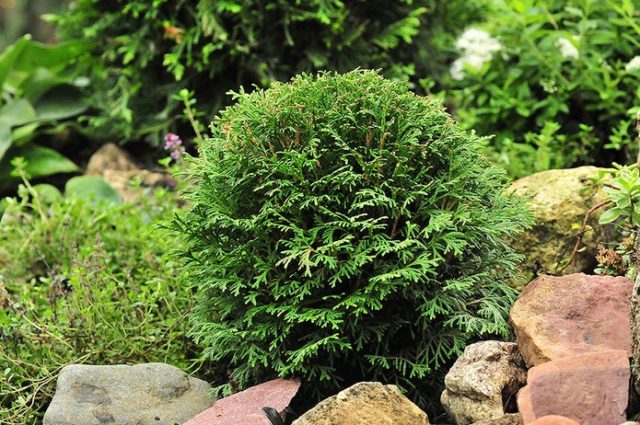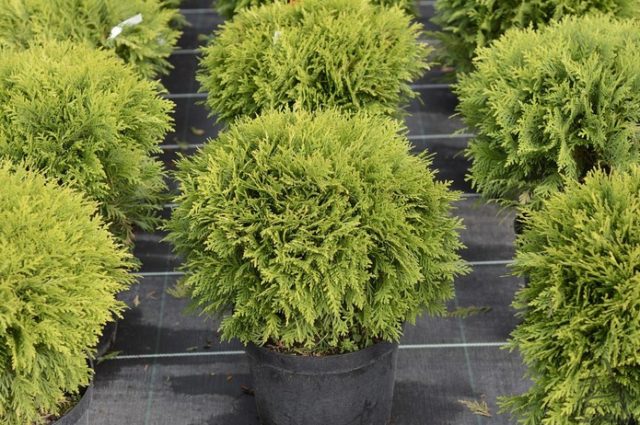Content
Thuja Danica is a dwarf variety of coniferous bush. The variety was obtained in Denmark in the middle of the twentieth century; it has been growing in the Botanical Garden BIN since 1992. It is used to decorate rocky gardens and create green borders.
Description of western thuja Danica
Thuja Danica has a brown or reddish bark that flakes off. It grows very slowly, tolerates frost well. When choosing a landing site, it should be borne in mind that thuja Danica loves light, but it can grow in partial shade.
Thuja Danik's needles are emerald green, elegant and lacy. The crown is dense, looks very decorative. The arrangement of needles and branches is dense, reminiscent of emeralds.
Sizes of an adult plant thuja Danica
Tui Danica is a dwarf variety, about 60 cm high. The crown is spherical, up to 1 m in diameter. The description of the size of the Tui Danika does not always coincide with the real ones. On good soil, it may be slightly larger, and on poor soil, it may be less in height and volume.
Varieties and varieties
In addition to Danik, several other varieties belong to the miniature forms of western thuja with ordinary green scaly needles:
- Dumoza;
- Globoza;
- Hetz;
- Midget;
- Hovey;
- Little Champion;
- Little Jam.
The size of the bush is similar to that of Danica, Aureya Nana, it differs only in the color of the needles and the shape of the crown slightly elongated upward. Aurea is yellow-green in color, then turns light green, and brownish-yellow in winter.
Thuja Globoza also has a spherical crown shape, it is slightly larger than the Danica variety. The height of the bush is 1.2 m, and the width of the crown is 1 m.
There is also a dwarf form of Globoza Nana. The shrub is only 30 cm high and resembles a small green ball. Perfect for rock gardens and stone gardens with miniature flowers and ornamental grasses.
The use of thuja Danica in landscape design
Thuja western Danica, according to the photo and description of gardeners, is decorative throughout the year, it looks beautiful in the foreground of any composition. Thuja look beautiful in small containers, displayed along the paths in the garden or on the front staircase. It is the ideal material for trimmed evergreen curbs.
Breeding features
Tuyu Danica is propagated by cuttings. This method allows you to transfer all the properties of the mother plant to the seedlings. Thuja from the cutting will have the same spherical crown, needles color and small size.
For harvesting cuttings, 2-year-old shoots are suitable, about 10-15 cm long. They must not be cut off, but broken off together with the "heel", this will contribute to better rooting.
Rooting process description:
- Needles are removed from the bottom of the cutting.
- For rooting, take a planting container and a loose soil mixture (turf soil, sand, peat).
- The cutting is placed in the soil to a depth of 5 cm.
- Then moisten with a spray bottle.
- Cover the stalk with a bag, and put it on a light, warm windowsill.
- Open periodically, and spray from a spray bottle, maintaining 100% humidity, making sure that mold does not form.
- After 2-3 months, the cuttings will begin to take root.
In the spring, rooted cuttings can be planted in a garden bed in a school for subsequent growing, and a year later they can be planted in a permanent place.
Planting and caring for thuja Danica
Having bought a spherical Danica thuja sapling in the garden center, or having grown it yourself from a cutting, prepare the soil on the site. It is not only the correct fit that is important, but also the subsequent care.
A young seedling planted in the ground is watered regularly during the first month, this is important for good survival. The trunk circle is mulched with peat, compost, wood chips or needles. This will prevent weeds from growing and keep moisture in the ground.
Recommended timing
You can plant thuja Danica in open ground in spring and autumn. Spring and autumn plantings have their pros and cons. A plant planted in spring or summer will almost restore its root system by autumn and adapt to the local climate. In spring, garden centers have a much larger selection of quality seedlings than in autumn. If you need a lot of planting material, this is an important argument in favor of spring planting of thujas.
Not all garden centers provide quality care for plants, so you can buy a sick or weakened plant in the fall. Supporters of autumn planting believe that the later the Danik thuja is planted, the better. In the fall, you can buy a seedling at a bargain price thanks to seasonal sales.
Site selection and soil preparation
When planting and caring for thuja western Danica, it is important to choose the right place: without stagnant water, well lit, where there is direct sunlight for at least 6 hours a day. In the shade of the thuja, the crown becomes loose and delicate. The plant's immune system weakens over time, and it becomes more susceptible to fungal diseases.
Thuja Danica is not demanding on the soil; it can grow in any area. But he prefers moist, breathable soil. On poor, sandy soil and with insufficient moisture, the thuja needles become pale green, the bush begins to bear fruit often and abundantly.
Landing algorithm
In thuja western Danica (Danica), the description of planting and subsequent care for gardeners is not difficult. The main thing is to properly deepen the root collar.
Process description:
- Planting pits are prepared for seedlings. If a hedge is being planted, a trench is made.
- The size of the planting hole should ideally be twice as wide and deeper than the root ball.
- The root collar of the thuja should be at ground level or 1-2 cm higher, since the soil can sink, and the root collar will be buried.
- A lump is kneaded or combed from a container plant, the mesh or burlap is not removed, they will quickly rot.
- Having put the plant in a hole, the remaining space is covered with soil so that there are no air pockets left inside.
- At the end, watered, spending about a bucket of water per plant.
After planting, it is advisable to shade the plant. To do this, you can use the facade mesh and install screens. Shading will help reduce moisture evaporation until the root system is restored.
Features of growing thuja Danica
Although thuja Danica is an unpretentious plant, it requires constant care. If you neglect the fulfillment of the basic agrotechnical requirements, the thuja will lose its decorative effect or even die.
Watering and feeding schedule
In the first year of planting or transplanting, the Danica thuja is regularly watered once a week. A bucket of water is consumed for each plant. Thuja respond well to sprinkling - watering over the crown. From the second year, the land under the conifers is loosened 1-2 times a season, without going deep, since the root system is superficial.
It is better not to overfeed the plant, an excess of nitrogen fertilizers can lead to sad consequences. The winter hardiness of thuja Danica will decrease. In the spring, a complex mineral fertilizer is applied for conifers, and in the middle or end of August - potash dressings.This will allow tuya Danica to better prepare for the winter.
Thuja Danica haircut rules
Thuja Danica, whose height does not exceed 60 cm, can be cut all year round, but it is better to do this when the air temperature is not too high. It is impossible to trim during rain and frost, plants can be done more harm than good. Only young green shoots are cut, trying not to touch last year's crown, so as not to leave bald spots.
A haircut is performed twice a season: the first time in May, the second in September. If this is not done, the bushes lose their correct spherical shape, the crown becomes loose, loses its high decorative effect.
Before cutting, to create a beautiful landscape design, a film is laid around the thuja Danik (pictured), then all the garbage will be easy to remove and take to the landfill. With hands in work gloves, they carefully clean out the old, dead needles from the base of the branches. It is advisable to clean it twice a season - in the spring before cutting and in August or September. Cutting the crown with manual garden shears starts from the bottom, and then goes around the entire perimeter.
Preparing for winter
In autumn, the color of the needles changes to brown-green and turns yellow inside the crown near the trunk. This is a normal process. The winter color of the needles is a defense mechanism that helps the plant to overwinter, and partially protects against spring burns.
Autumn care for Danica's globular thuja includes shelter. Its needles must be protected from early spring sunburn. It can burn badly, lose its decorative effect, and then it will take a long time to restore the needles. The plant is sheltered from the bright spring sun. This can be done in late autumn or February. For shelter, you should not use various geotextiles, it is better to take white coarse calico or burlap. You can put shading screens on the south side, where the sun shines more and more.
Pests and diseases
Tuya Danica, according to the description of gardeners, is unpretentious in care and is considered a resistant plant, but sometimes it is damaged by diseases and pests. As a rule, thuja diseases are of fungal origin; systemic fungicides are used against them.
There are also specific pests:
- thuya false shield;
- thuya aphid.
To combat harmful insects, contact and systemic insecticides are used.
Conclusion
Thuja Danica is a compact spherical shrub with a dense, bright green crown. It is a wonderful decoration for the garden. The advantages of the variety include undemanding soil, resistance to drought and excess moisture, frost resistance. You can grow thuja Danica yourself from a cutting.
Testimonials














